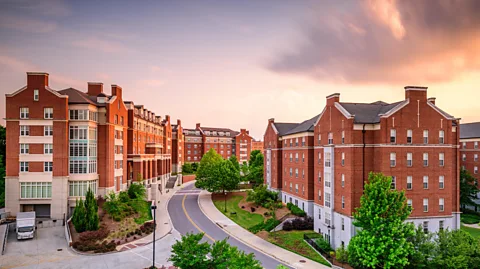This is how to really make money from student life
 Getty Images
Getty ImagesEarning money from university without attending a single lecture.
When Tim Collins left his job in sales about five years ago, he decided to invest full time in student housing even though he doesn’t yet have university-aged children.
“A lot of people invest in real estate for long term, but I wanted to make cash today,” said Collins, who lives on Vancouver Island, off Canada’s Pacific Coast, and now owns a dozen properties near Toronto. He also runs a site called Student Rental Investing to teach others how to get into the sector. “With student rentals I could make significant amount of cash flow.”
Collins isn’t the only one who has benefitted from the growth in the private student-housing market, which brings him returns on his investment of as much as 25% annually. While small, independent, family-owned businesses have been investing in student housing for decades, buying up off-campus homes when their children go to university, the game changer has been the private apartment complexes built expressly for student housing that began popping up about 20 years ago in the United States, said Jaclyn Fitts, director of student housing at CBRE’s capital markets group. Now the trend has taken hold globally and purpose built student housing is growing in countries like Ireland, Australia and South Africa.
 Alamy
AlamyInvestment funds started taking note and in 2004, American Campus Communities was the first student housing real-estate investment trust, or REIT, in the US to go public. A handful of others in the US, like Education Realty Trust, have followed suit. In the UK, Unite Group manages and develops student housing in nearly 30 cities, while newcomer Empiric Student Property focuses on higher end, city centre properties such as those in Bath, Manchester and Glasgow.
That steady growth, said Fitts, has become an explosion in the past few years as more funds have moved into the space. The number of transactions in the student housing sector grew 50% from 2015 to 2014 and the dollar amount of those deals nearly doubled to $5.6bn, according to CBRE. In the UK, the market activity more than doubled over that same period — to £5.5bn ($7.8bn) in 2015 from £2.2bn ($3.12bn) in 2014, according to Unite.
“There were always a lot private investors,” said Fitts. Now student housing has “become a more accepted asset class” among a variety of investors, she said. Funds have become even bigger players in the space buying up about 30% of student housing deals in 2015, up from 13.9% in 2014, according to CBRE. The entrance of pension funds and other investors have heated up the UK market, according to Joe Lister, Unite’s CFO. “The private sector is forming the bulk of new beds.”
While analysts say there is still room for more deals, investors should be careful to shy away from markets where the student housing market is overbuilt and enrolment could drop.
The right mix of trends
The growth is the result of a perfect storm of more students in university, tighter university budgets for housing and the global real-estate downturn. Traditional property investments, such as residential or commercial spaces, that are more tied to the health of the overall economy took a beating during the financial crisis starting in 2008.
By contrast, student housing has proven to be largely “recession resistant,” said Rob Mathias, a principal of Harrison Street Real Estate Capital, LLC, which has invested $7bn in student housing since it got its start in 2005.
 Getty Images
Getty ImagesWith more high school graduates and more of them going to university, full time enrolment in US undergraduate institutions is expected to grow from 10.9 million students in 2015 to 12.3 million students in 2024, according to the US National Center for Education Statistics. In the UK, even as fees have grown, the number of university students has also continued to rise. In 2015 532,300 applicants started at UK higher education institutions, up 3.9% from 2014 according to the Universities and Colleges Admissions Service (UCAS), which handles admissions to British universities.
At the same time as budgets are squeezed, universities aren’t able to build new housing for the influx of students. American universities typically house about 25% to 30% of their students, said David Adelman, CEO of student housing developer, Campus Apartments. Often they have only enough housing for first year students, leaving students to fend for themselves for following years.
 Unite Group
Unite GroupIn addition, today’s students have different expectations said Adelman. They are accustomed to having their own bedrooms and bathrooms, and “those expectations are flowing through when they are going to college,” he said.” They are looking for modern amenities like common study areas, ubiquitous wireless access and security cameras.
What to expect
If you are putting your money in to student housing, returns can vary widely depending on where the project is located, the type of accommodation it offers and what is involved in converting it to meet student needs, said Peter Stelian, CEO and founder of Blue Vista Capital Management, which manages about $2bn of student-housing investment and owns Peak Campus, a student-housing-development company in the US. “With student housing, every deal is its own story,” said Stelian, who says returns can range between 7% and 18%.
The lower-risk deals, he said, are housing units that are close to a large, growing campus and located in an area with a tight housing market such as those near the University of California, Berkeley. In places like the University of Central Florida there is opportunity to build a little farther from campus, though this plan would involve taking on more risk because generally demand tends to go down the farther the housing from campus, said Stelian. Investors willing to take on a building that needs to be modernised can ultimately earn more for their efforts, while those willing to build a property from the ground up stand to make the most.
 Getty Images
Getty ImagesThe firm is also looking for opportunities in Europe, where the student-housing market is more nascent. The firm closed its first UK investment last year and is planning additional investments in Ireland and continental Europe. “We’re finding that in those markets demand outstrips supply,” said Mathias, who sees more international students heading to Europe in the future because of cheaper tuition fees.
About a third of students in Unite’s UK properties are international and the company even has an office in China.
Still as the number of investors has grown, the difference between the return on investment for multi-family housing and student housing has narrowed in the past five years and yields are slightly below 6% in the US, according to CBRE.
How to invest
The most straightforward way to invest in student housing is to buy shares in a publicly traded REIT. Some of the new funds devoted to student housing may also accept individual investors, but many are open only to institutional investors like endowment or pension funds.
Bolder investors can follow Collins’ example, buying, managing and renting out properties to students on their own. Collins warns that student housing is far more time intensive than other types of property investments because it requires more upfront research and ongoing management. Those who want to follow his example should focus on a few campuses rather than spread themselves too thin.
At most universities, properties within walking distance of a campus or on a university shuttle bus route and close to shopping areas are the surest bet. But investors still need to check things out in person. “Every school has a different demographic and a way they think about things,” said Adelman. “You can look at map and a property seems close, but when you talk to students you find out it’s in the wrong neighbourhood.”
Lister warns that despite the overall growth in the UK student housing market, not all universities will see more students. Fees at UK universities are capped at £9,000 ($12,800) a year, so competition for top universities is fierce while weaker universities may see a drop off in students. “Growth [in student numbers] will continue to outpace supply,” he said. “But the stronger institutions will grow more than the weaker ones.”
The risks
While there are upsides, there are also downsides to consider. Student housing requires more maintenance and turnover at student-housing properties is about 60%, Adelman said. Investors have to be prepared to deal with wear and tear from constant moving and employ careful marketing with students to keep the property full.
In addition, said Fitts, insurance premiums tend to be slightly higher because the rental properties are furnished.
Rental contracts are also different from residential housing. While investors can make more money from renting out properties per bed, they also have to wrap extras such as Internet and electricity into one payment. Students often sign leases for the following academic year by the time they leave for the summer holidays. So if you miss that window you’re left with an empty property for a year.
In Europe, said Mathias, investors do have to maintain a relationship with universities which point students towards approved housing.
Landlords also need to maintain a close relationship with students. “It’s totally different from a traditional apartment, where a property manager stays out of your life,” said Stelian. “In student housing, managers are compensated to be part of a student lives.” In professionally developed properties, investors often hire an onsite manager to coordinate activities and deal with student concerns.
Finally, investors have to also appeal to parents, who guarantee rental agreements for their kids. “Parents want to make sure their kids are taken care of,” Stelian said.
To comment on this story or anything else you have seen on BBC Capital, head over to our Facebook page or message us on Twitter.
In demand: Where are students studying?
Between 2007-2012, these US states saw the largest jump in university student enrollments.
State Percentage increase
Iowa 40.9
West Virginia 38.8
Idaho 37.0
Utah 31.2
Florida 26.4
Oregon 25.5
Virginia 23.1
Texas 21.4
Georgia 20.2
South Carolina 19.2
Credit: US National Center for Education Statistics
